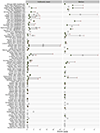Toenails as a biomarker of exposure to arsenic: A review
- PMID: 33075355
- PMCID: PMC7987585
- DOI: 10.1016/j.envres.2020.110286
Toenails as a biomarker of exposure to arsenic: A review
Abstract
This systematic review summarizes the current evidence related to the reliability of toenail total arsenic concentrations (thereafter "arsenic") as a biomarker of long-term exposure. Specifically, we reviewed literature on consistency of repeated measures over time, association with other biomarkers and metal concentrations, factors influencing concentrations, and associations with health effects. We identified 129 papers containing quantitative original data on arsenic in toenail samples covering populations from 29 different countries. We observed geographic differences in toenail arsenic concentrations, with highest median or mean concentrations in Asian countries. Arsenic-contaminated drinking water, occupational exposure or living in specific industrial areas were associated with an increased toenail arsenic content. The effects of other potential determinants and sources of arsenic exposure including diet, gender and age on the concentrations in toenails need further investigations. Toenail arsenic was correlated with the concentrations in hair and fingernails, and with urine arsenic mainly among highly exposed populations with a toenail mean or median ≥1 μg/g. Overall, there is a growing body of evidence suggesting that arsenic content from a single toenail sample may reflect long-term internal dose-exposure. Toenail arsenic can serve as a reliable measure of toxic inorganic arsenic exposure in chronic disease research, particularly promising for cancer and cardiovascular conditions.
Keywords: Arsenic; Biomarker; Biomonitoring; Exposure; Toenail.
Copyright © 2020 Elsevier Inc. All rights reserved.
Conflict of interest statement
Conflict of interest
The authors declare no competing financial interest.
Declaration of interests
The authors declare that they have no known competing financial interests or personal relationships that could have appeared to influence the work reported in this paper.
Figures


References
-
- Abdulrahman F, Akan J, Chellube Z, Waziri M, 2012. Levels of Heavy Metals in Human Hair and Nail Samples from Maiduguri Metropolis, Borno State, Nigeria. World Environment 2, 81–89. 10.5923/j.env.20120204.05 - DOI
-
- Aguiar AR, Saiki M, 2001. Determination of trace elements in human nail clippings by neutron activation analysis. Journal of Radioanalytical and Nuclear Chemistry 249, 413–416. 10.1023/A:1013235123875 - DOI
Publication types
MeSH terms
Substances
Grants and funding
LinkOut - more resources
Full Text Sources
Other Literature Sources
Medical

